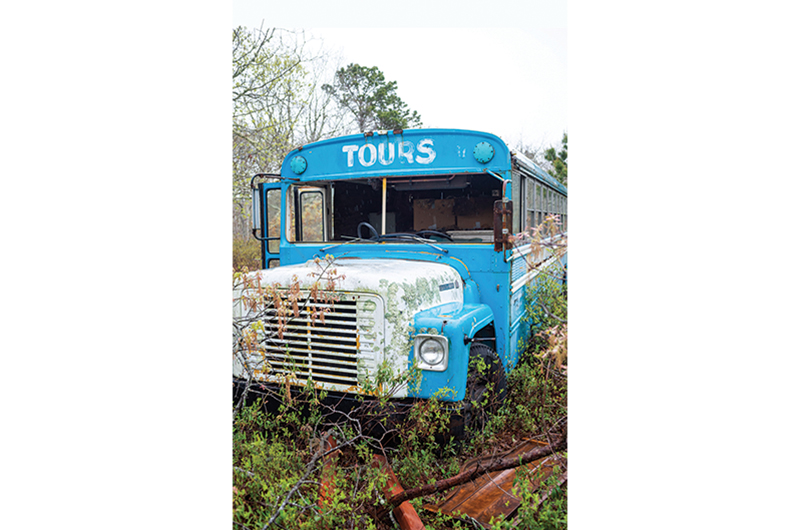For more than twenty years, a blue-and-white bus crammed with kitchenware, books, and old furniture has sat abandoned on a heavily wooded lot a half-mile from our house near Quansoo. Three twenty-first-century Tom Sawyers – thirteen-year-old grandson Matty and two of his buddies – climb through dense brush and oak trees to explore the bus. Matty reports that the back door has been smashed open and an upright piano in the rear of the bus has been badly damaged by rain.
I pay a visit to see if there is anything I can do to protect the piano and other contents. The bus’s front door and several side windows are open to the elements. I can’t close the back door. In the rear, I notice the edge of a cracked picture frame. It holds twenty-one family photos. Why not return the photos to the owner and, in the process, learn the story of the abandoned bus?
Enter Larry Hepler, Quansoo’s unofficial historian. Hepler tells a tale that connects the bus to one of the Island’s most colorful characters, Clarence A. “Trip” Barnes III. House mover, used-car salesman, incomparable auctioneer for good causes, and winner of good citizenship awards, Barnes has been called in this magazine “a one and only, descended on one side from a Massachusetts attorney general and on the other related to P.T. Barnum.” The P.T. Barnum in him may help explain one of Trip’s Greatest Shows on Earth: stripping a fleet of buses of their seats and turning them into rent-earning mobile storage units.
The contents of the bus, in turn, can be traced to one of the Island’s most historic homes: the Mayhew-Hancock-Mitchell House, a Quansoo farmhouse that, according to family lore, was built by Thomas Mayhew Jr. to serve as his residence and a meeting house for the Native Americans he converted to Christianity. (Mayhew Jr.’s father “purchased” the Island in 1641.)
Ownership of the house passed to the Hancocks, including Samuel Hancock, captain of merchant vessels engaged in transatlantic trade, and then to the Mitchells, who operated whaling ships and, in the twentieth century, farmed. Adelbert “Delly” Mitchell and his wife, Iva Maye West Mitchell, raised one hundred sheep, twenty-five cows, and five children there. Delly died in 1939. In 1970, Iva Maye negotiated a sale of the property to Florence B. “Flipper” Harris, an Island conservationist who purchased the property with the sole intention of turning it over to the Sheriff’s Meadow Foundation.
Under the terms of the deal, Harris permitted the Mitchell family to continue living seasonally in the home until 2000, as long as they did not alter or update the structure. Leslie Cosgrove, granddaughter of Delly and Iva Maye Mitchell and one of the last people to live in the home, fondly recalls her fifty years spent there, despite the absence of electricity and indoor plumbing. “It’s a peaceful location,” she said. “I am grateful to the Lord for my time there.”
In 2000, when it came time to move out of the house, Clarence A. Barnes III Moving & Storage was hired to load Cosgrove’s family’s possessions into a bus and drive it about one mile away onto an undeveloped 6.6-acre wooded lot she owned. Barnes doesn’t recall billing Cosgrove for the bus’s rental in years. “I felt guilty about billing her,” he said. As for Cosgrove, she always thought she would build on her lot when she retired and create a new space for her family’s belongings. More than two decades have passed. Cosgrove says she hasn’t returned to the Vineyard since leaving in 2000.
Maybe she will never return. She is busy overseeing repairs to the kitchen and bathroom in her Pleasant Valley, Connecticut, home, built in 1850, and coordinating long-term restoration projects at the First Congregational Church of Barkhamsted, Connecticut. When I mail her the photos I found in the bus and a new book about the early history of her family’s farmhouse, she sends me a handmade thank you card. On the front is a photo of a Quansoo sunset.
I’m delighted by the Sheriff’s Meadow Foundation’s million-dollar restoration of the Mayhew-Hancock-Mitchell House and the foundation’s stewardship of the farm.
But I’m saddened by the sight of the bus. Its contents disintegrate. Kitchenware and other objects, having been removed from the bus, lie on the ground, deteriorating and decomposing.
I’m reminded of David R. Foster’s book A Meeting of Land and Sea (Yale University Press, 2017). In attempting to determine the Vineyard’s future, Foster suggests a rusted ruin of a car behind Arrowhead Farm in West Tisbury and a bathtub from the 1960s sitting in the state forest may provide a way for us to “gain a new perspective on the island and ourselves.” Maybe the abandoned bus also asks us to consider humans’ complacency about the environment.
Others think about the bus somewhat differently. An abutter says the bus “is an eyesore and a place for varmints to roost and reproduce. It would be grand to get rid of it.” The children in the neighborhood, however, find the bus an enticing mix of mold, mildew, and mystery. Rosie, my eight-year-old granddaughter, offers a one-word assessment: “Cool!”





